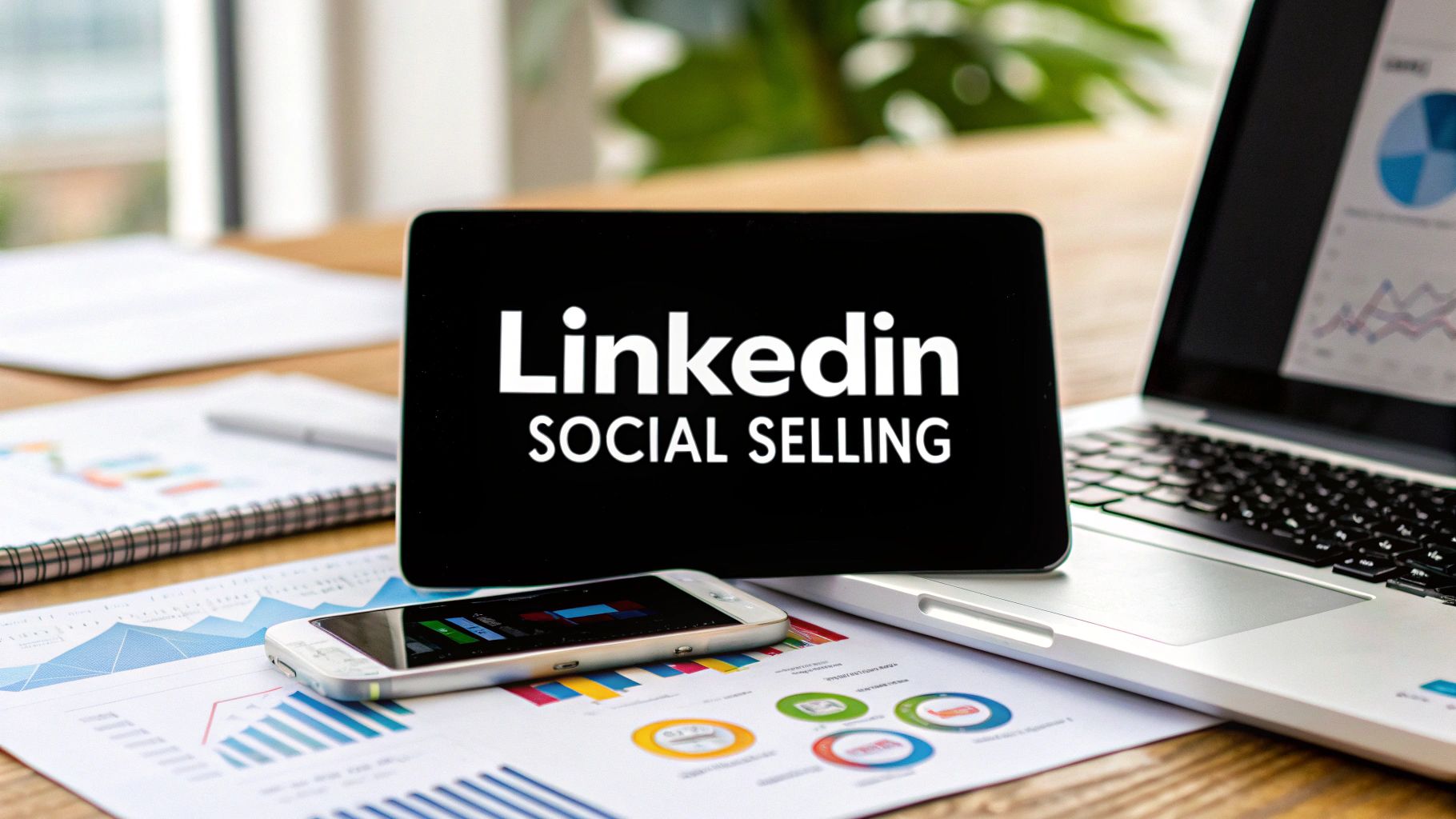
Mastering Social Selling on LinkedIn
Published on 2025-07-25
Social selling on LinkedIn is really just about using the platform to find the right people, connect with them, and build real relationships that eventually lead to sales. It’s a shift away from the old-school hard sell. Instead, you focus on giving value first, which naturally warms up conversations and, in my experience, leads to bigger and better deals.
Why Social Selling on LinkedIn Actually Works
Let's be real—traditional sales tactics are getting tired. No one enjoys making endless cold calls or sending generic email blasts that get ignored. This is where social selling on LinkedIn comes in. It’s not just another tactic; it's a necessary evolution for any sales team that wants to stay relevant. You have to move from a "what can I sell you?" mindset to a "how can I help?" one.
Instead of jumping straight to a pitch, the best social sellers lead with things like:
- Helpful Content: Sharing articles, your own insights, or data that genuinely helps your prospects understand or solve a problem they're facing.
- Real Engagement: Hopping into conversations, leaving thoughtful comments on posts, and congratulating people on their achievements. It shows you're paying attention.
- Personal Connection: Taking the time to build actual rapport before you even think about mentioning your product or service.
The Unmatched Power of the Platform
What makes this whole approach so effective is LinkedIn's unique position. It's the world's largest professional network, with over 1.2 billion members and a massive 1.77 billion monthly visits. But it’s not just the size of the audience; it’s the quality.
To really grasp why this is a goldmine for sales, take a look at who is actually on the platform.
Key LinkedIn User Demographics for Sales Professionals
| User Segment | Statistic | Relevance for Social Selling |
|---|---|---|
| B2B Buyers | 50% of B2B buyers use LinkedIn to make purchasing decisions. | This is where your target audience is actively researching and vetting solutions. You need to be there. |
| C-Level Executives | Over 10 million C-level executives are on LinkedIn. | You have direct access to decision-makers, bypassing traditional gatekeepers. |
| High-Income Earners | 45% of LinkedIn users have an annual income over $75,000. | The platform is filled with professionals who have significant purchasing power. |
These numbers aren't just vanity metrics; they prove that your most valuable prospects are on LinkedIn, and they're using it to find solutions. This is precisely why social selling here isn't just a "nice-to-have" anymore—it's essential.
The core idea is simple: social selling isn’t really about selling at all. It’s about building trust. When a prospect sees you as a credible, helpful expert instead of just another salesperson, they’re far more likely to reach out when they're ready to talk business.
From Profile View to Sales Pipeline
When you nail this, your entire sales process changes. Your LinkedIn profile stops being a resume and starts being a resource hub. Your content acts like a magnet for qualified leads. Your network becomes a reliable source of warm introductions and referrals.
By consistently showing up and sharing valuable insights, you stay on your prospects' radar. So, when the time comes for them to buy, you’re the first person they think of.
To really dig into the mechanics of this, from setting up your profile to filling your pipeline, it's worth exploring guides on the smart way to sell on LinkedIn from profile view to pipeline. This relationship-first approach doesn't just feel better; it shortens sales cycles and builds a predictable stream of high-quality leads who already see you as an authority.
Crafting Your Buyer-Centric LinkedIn Profile
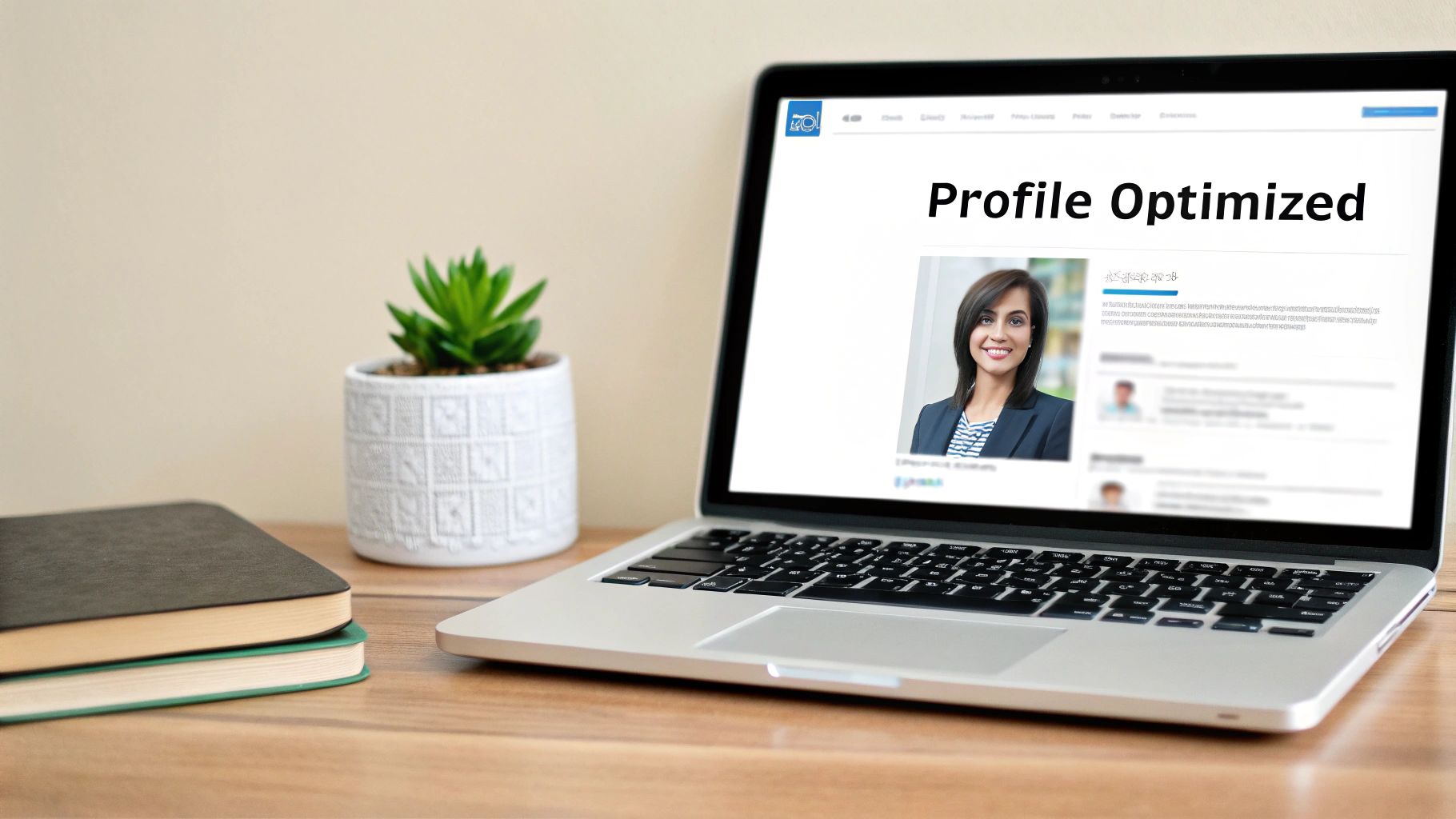
Let's get one thing straight: your LinkedIn profile is not your resume. Think of it as your digital storefront, open 24/7. If you're serious about social selling, your profile needs to stop talking about you and start speaking directly to your ideal buyer. Every single piece of it—from your headline down to your experience—is a chance to build trust and show prospects you get their world.
The most important shift you can make is mental. Stop thinking, "Here's what I do," and start thinking, "Here's how I help people just like you." That simple change is the entire foundation of a profile that actually attracts and converts. It turns a static page into a dynamic resource that's working for you, even when you're not online.
Overhaul Your Headline for Immediate Impact
Your headline is prime real estate. Seriously. It’s the one thing that follows you everywhere on LinkedIn—popping up in search results, next to your comments, and in every connection request you send.
A generic title like "Account Executive" or "Sales Manager" is a completely wasted opportunity. It tells people what your role is, but it says absolutely nothing about the value you bring to the table.
Instead, you need a headline that speaks directly to your ideal customer’s problems or aspirations. I've found a simple formula that works wonders: [Your Title] | Helping [Your Target Audience] Achieve [Their Desired Outcome].
Just look at the difference:
Before: "Marketing Manager at Tech Solutions Inc."
After: "Marketing Manager | Helping B2B SaaS Founders Build a Predictable Lead Generation Engine"
Before: "Financial Advisor"
After: "Financial Advisor | Guiding Young Professionals Toward Financial Freedom and Early Retirement"
See? This approach instantly qualifies you in the eyes of the right person. When a prospect lands on your profile, their first impression is, "Okay, this person exists to solve my exact problem."
Write an "About" Section That Tells a Story
This is where you get to be human. Forget the stuffy, third-person bio. It’s time to write a compelling story in your own voice. This isn’t the place to just list your job history; it's where you build a genuine connection.
Start by entering your prospect's world. What are their biggest headaches? What’s keeping them up at night? Show them you understand their struggles before you even whisper a word about your solution.
A great "About" section is a bridge. It connects your prospect's current pain to their desired future state, and positions you as the guide who can help them cross it.
Once you’ve established that empathy, briefly share a bit of your own story. Why are you so passionate about helping them? Finally, wrap it up with a crystal-clear call to action. Do you want them to connect with you? Check out your company's site? Drop you a message? Don't be shy—tell them exactly what to do next.
Showcase Results, Not Responsibilities
When someone scrolls down to your "Experience" section, they couldn't care less about your day-to-day job duties. They're hunting for proof. They want to see that you can actually deliver results. Your job is to transform those boring task lists into a powerful portfolio of accomplishments.
For every role, zero in on the tangible, quantifiable achievements.
Instead of: "Managed key client accounts."
Try this: "Grew key client accounts by an average of 35% YoY by identifying new expansion opportunities."
Instead of: "Responsible for lead generation."
Try this: "Generated over 200 qualified leads in Q3 by implementing a new content marketing strategy."
Instead of: "Sold software solutions."
Try this: "Helped 50+ businesses streamline their operations, resulting in an average 15% reduction in costs."
Using bold numbers and specific outcomes makes your impact undeniable. It gives prospects the social proof they need to see you as a credible expert, not just another salesperson.
And one last thing: use your "Featured" section to pin your greatest hits. This could be a powerful client testimonial, a detailed case study, a popular article you wrote, or a link to a resource they'd find useful. This curated content is the final polish, reinforcing your expertise and making your profile a true hub for social selling on LinkedIn.
Finding and Connecting With the Right People
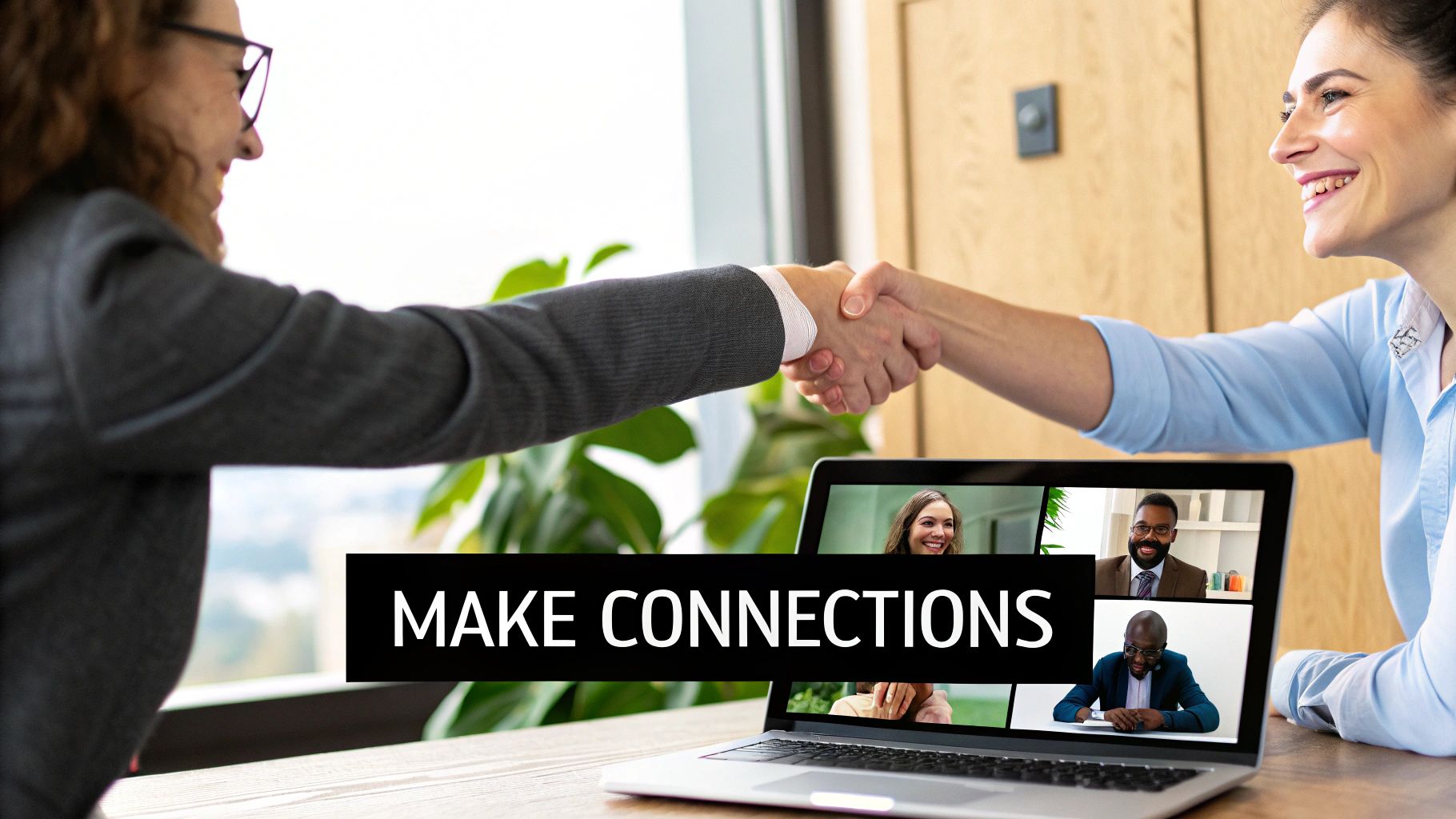
Alright, your profile is now polished and ready to attract your ideal buyer. The next step is to go out and actively find them. Real success in social selling isn't about bloating your connection count—it's about building a high-quality, relevant network.
This means we're moving away from random outreach. Instead, we’re going to get strategic and put you in front of the decision-makers who actually matter. Forget just typing a job title into the search bar. We need to go deeper to build a laser-focused list of prospects who will genuinely benefit from what you do. This is where you’ll start seeing a real return on the time you put in.
Mastering LinkedIn Search Like a Pro
The standard LinkedIn search is way more powerful than most people give it credit for, especially once you get the hang of Boolean operators. These are simple commands that let you dial in your searches with incredible precision, cutting through all the noise to find exactly who you’re looking for.
I use these constantly. Here are the core ones:
- AND: This narrows your search. If you search for
"Marketing Director" AND "SaaS", you’ll only see people with both keywords in their profile. Simple and effective. - OR: This broadens your search. A search like
(VP OR "Vice President")will catch profiles using either title, so you don't miss anyone. - NOT: This excludes terms you don't want. Looking for marketing leaders but want to avoid the retail sector? Try
"Marketing Manager" NOT "Retail".
By combining these, you can build search strings that pinpoint your ideal prospects with surgical accuracy. Honestly, this one skill is a major separator between amateurs and pros in the social selling world.
Is LinkedIn Sales Navigator Worth It?
I get asked this all the time. Look, the free version of LinkedIn is a fantastic place to start. But if you're serious about scaling your social selling, LinkedIn Sales Navigator is a complete game-changer. It’s not just a tool; it's an entire sales ecosystem.
The biggest advantage is its advanced filtering. You can zero in on prospects by company size, seniority level, years they've been in a role, and dozens of other criteria that the free search simply doesn't have. On top of that, its "Lead Recommendations" feature proactively suggests new prospects based on your activity, essentially doing some of the prospecting for you.
My rule of thumb is this: Master the free search with Boolean operators first. Once you have a consistent daily process and feel like you're hitting a wall with the free platform, it’s time to invest in Sales Navigator. It will accelerate your existing efforts, not create them from scratch.
The Art of the Connection Request
This is where so many people stumble. They find the perfect prospect, then immediately send a generic, empty connection request. Or worse, they connect and immediately launch into a sales pitch. That’s the fastest way to get ignored or even have your account flagged.
Think of your connection request as your first impression. It has to be personalized and offer a reason to connect before you ever think about asking for something. A great request clearly shows you’ve done your homework.
Here are a few real-world examples that actually get accepted:
- Reference Their Content: "Hi [Name], I really enjoyed the perspective you shared in your recent post on [Topic]. Your point about [Specific Insight] really resonated. I'd love to connect and follow your work."
- Mention a Mutual Connection: "Hi [Name], I see we’re both connected with [Mutual Connection's Name]. I’ve always been impressed with their work in [Industry/Field], and I'm always looking to connect with other sharp professionals in the space."
- From a Shared Group: "Hi [Name], I saw your thoughtful comment in the [LinkedIn Group Name] discussion about [Topic]. It's a subject I'm also passionate about. Would be great to connect."
See the pattern here? No pitch. No ask. Just genuine, relevant context that makes saying "yes" a no-brainer. Building a valuable network is a marathon, not a sprint. If you want to dive deeper, you can find more practical LinkedIn networking tips in this detailed guide. The secret is to always make it about them, not you.
Creating Content That Builds Real Authority
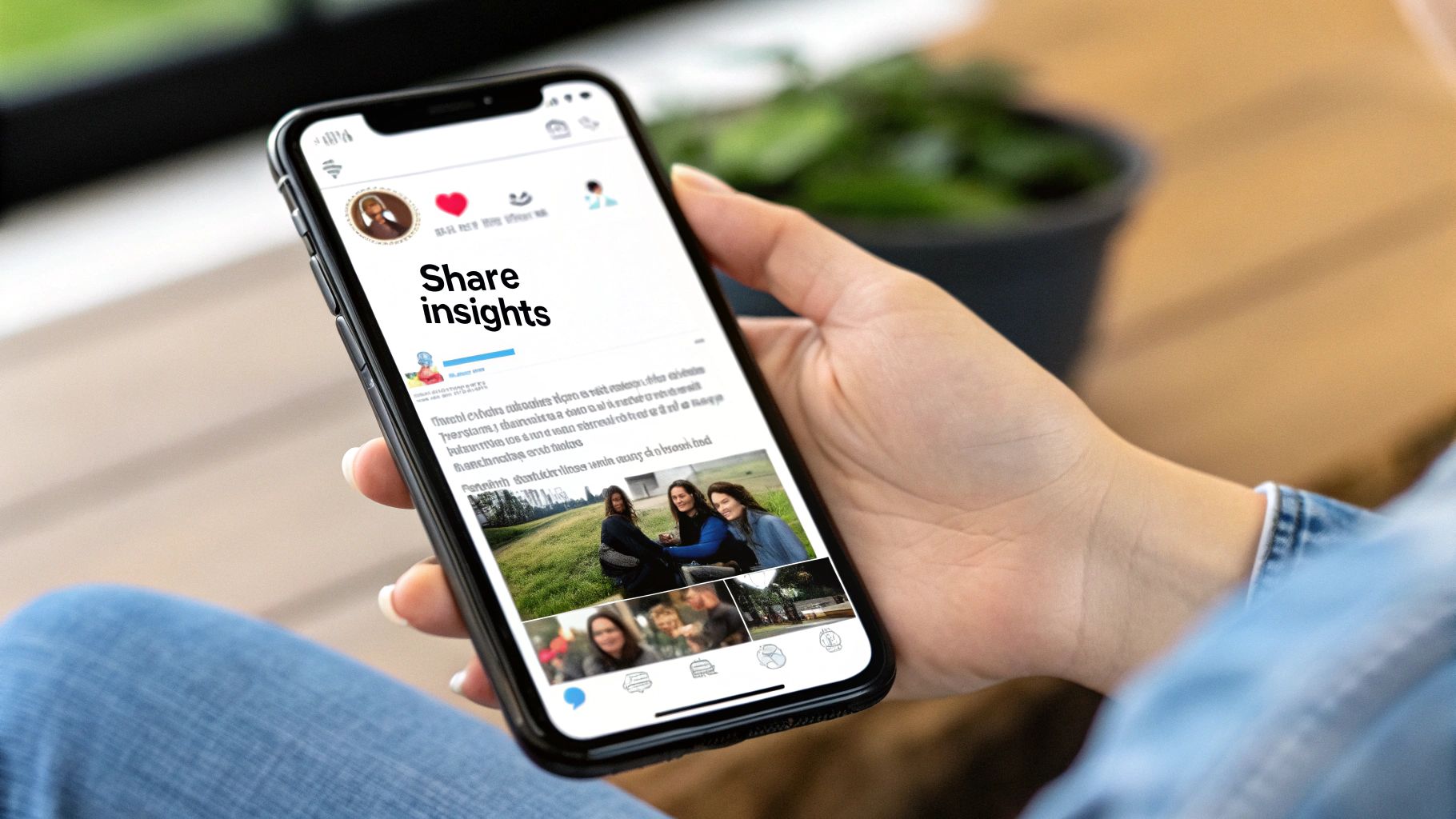
Alright, you've started building a network of the right people. Now comes the real work: turning those connections into meaningful relationships. This is where you graduate from being just another name in their network to becoming a trusted, go-to authority in your field.
And how do you do that? With consistent, genuinely helpful content.
This isn’t about just blasting your sales pitch into the digital ether. It's about generously sharing what you know to help your audience solve their biggest headaches. Think of it as warming up the conversation so that when you eventually reach out, it doesn't feel cold at all.
Shift Your Mindset From Selling to Serving
Here’s the biggest mistake I see people make: their content is all about them. "We won this award!" "Check out our new feature!" Frankly, your audience doesn't care—unless you can tell them exactly how it makes their life better.
Before you hit "post," run your content through a simple filter: "Does this actually help my ideal customer?"
If the answer is no, scrap it. Great content is always about the user. It teaches them something new, gives them a fresh perspective, or just makes their day a little easier. This mindset is the core of social selling and the secret to generating inbound leads who are already interested in what you have to say.
Your content should be so valuable that people feel like they should be paying for it. That's the bar. When you give away your best stuff for free, you build incredible trust and position yourself as the only expert they need.
The Content Formats That Actually Work
LinkedIn gives you a few different tools in your content toolbox. A smart strategy mixes them up to keep your feed interesting. From my experience, certain formats just hit different.
Text-Only Posts: Don't underestimate these. Short, punchy posts with a killer opening line can get massive engagement. They’re perfect for sharing a quick thought, asking a provocative question, or telling a relatable story.
Carousels (PDFs): These are absolute gold for breaking down complex ideas into easy-to-digest slides. They keep people on your post longer (what we call "dwell time"), which the LinkedIn algorithm rewards. Use them for step-by-step guides, checklists, or turning a blog post into a visual summary.
Video: Nothing builds connection like video. Keep it short and sweet—under 90 seconds is the sweet spot. A quick tip filmed on your phone or a behind-the-scenes look at your process feels personal and grabs attention.
Image Posts: A powerful image paired with a compelling caption can stop someone mid-scroll. Think high-quality photos, useful infographics, or even a simple screenshot that illustrates your point.
If you’re sharing an external resource, be strategic about where you put the link. Learning how to add a link to your LinkedIn post the right way can make a huge difference in your click-through rate and reach.
How to Never Run Out of Content Ideas
We’ve all been there—staring at a blinking cursor with zero inspiration. The key to a sustainable content strategy isn't divine inspiration; it's a system. Your best ideas live at the intersection of your expertise and your audience’s pain points.
A Simple Framework for Ideas
Listen to Your Customers: What questions pop up on every single sales call? What are their biggest objections? Each one is a fantastic post idea waiting to be written.
Hang Out Where They Hang Out: Go browse industry forums or relevant subreddits. What are people in your target market complaining about or asking for help with? Answer their questions on LinkedIn.
"Teach What You Know": Just solve a tough problem for a client? Break down how you did it. Learned a hard lesson this week? Share it. That kind of raw authenticity is what really connects with people.
Engagement Is a Two-Way Street
Posting is only half the equation. Strategic commenting is just as powerful—if not more so.
Think about it: your feed is a curated list of opportunities. When a prospect or an industry leader posts something, leaving a thoughtful comment does two critical things.
First, it gets your name and face right in front of them. Second, it exposes you to their entire network. A great comment isn't just "Great post!"; it adds to the conversation, offers a different angle, or asks an intelligent follow-up question.
By consistently showing up—both in your own posts and in others' comments—you build a powerful presence that keeps you top-of-mind. This is the secret sauce that turns cold connections into warm conversations and, ultimately, closed deals.
Turning Connections Into Sales Conversations
https://www.youtube.com/embed/hsIP4iH25Wg
This is where all your hard work starts to pay off. You’ve polished your profile, built a network full of promising prospects, and you're sharing content that shows you know your stuff. Now it’s time to turn those digital handshakes into real business opportunities.
The secret? A value-first approach to outreach. Forget the immediate, hard sales pitch—that’s the fastest way to get ignored or, worse, disconnected. The goal here is to nurture the relationship, build genuine trust, and only then guide the conversation toward a discovery call when the timing feels natural.
The Value-First Outreach Playbook
Your first few messages after connecting should have nothing to do with your product. They need to be about them. Your only job is to start a real, human conversation. A fantastic way to do this is by referencing something specific you’ve noticed about them or their company.
Let's imagine you've just connected with someone who posted about a challenge their team is wrestling with. Instead of the generic "Thanks for connecting," try sending a message that proves you’re actually paying attention.
For example:
- Their Post: "Struggling to scale our content production without the quality taking a nosedive. It's a real bottleneck for us this quarter."
- Your Message: "Hey [Name], thanks for connecting. I saw your post about the content bottleneck—that's a tough nut to crack, and something I see a lot of companies dealing with. I actually came across an interesting article on [Relevant Topic] that had some great frameworks for scaling. Thought you might find it useful. No strings attached, just sharing!"
This approach hits all the right notes: it’s timely, it's relevant, and it provides immediate value without asking for a single thing in return. You’re not a salesperson; you're a helpful resource.
The golden rule of social selling outreach is to always give before you get. Offer a piece of advice, a helpful resource, or a thoughtful compliment. This simple act builds reciprocity and makes your eventual "ask" feel natural rather than transactional.
Pivoting to the Sales Conversation
After a few of these value-packed exchanges, you'll feel the dynamic shift. You're building rapport. The prospect starts seeing you as a credible expert, not just another random contact in their network. Knowing when to pivot from a friendly chat to a business discussion is an art, but there are clear signals to watch for.
Keep an eye out for these buying signals:
- They start asking you follow-up questions about your industry or expertise.
- They begin actively liking, commenting on, or sharing your content regularly.
- They mention a specific business pain point that you know your solution is built to solve.
When you spot one of these triggers, it’s your cue to gently guide the conversation toward business. You can do this by connecting their stated problem to your solution in a low-pressure way.
Knowing When to Make the Ask
Once you’ve clearly identified a pain point they're dealing with, the transition becomes much smoother. Now you can propose a more formal chat without it feeling jarring or out of place.
Here’s how you might phrase that transition:
- "You've mentioned a few times that [Specific Challenge] is a major priority for your team. That's actually a core problem my team and I specialize in solving for companies like yours. Would you be open to a brief 15-minute chat next week? I can share a few ideas on how you might tackle it, whether you work with us or not."
This is the moment where your investment in social selling on LinkedIn truly proves its worth. The numbers back this up: companies with a formal social selling process see up to 48% larger deal sizes, and 78% of salespeople using these methods outsell their peers who don't. Why? Because you’re not just another cold outreach—you’re a trusted contact.
Your value-first approach has earned you the right to make this ask. If you're interested in the data behind this, you can learn how social selling delivers real revenue on Optinmonster.com and see the impact for yourself.
How to Measure Your Social Selling Success
If you can't measure it, you can't improve it. That old saying is especially true for social selling. While building relationships on LinkedIn feels qualitative, you absolutely have to back it up with hard data to prove its value, get buy-in for more resources, and figure out what’s actually working.
Your first stop is probably LinkedIn's own Social Selling Index (SSI) score. It's a handy metric that grades you out of 100 based on four key activities, each worth 25 points:
- Establishing your professional brand: Is your profile complete and geared toward your ideal client?
- Finding the right people: How effectively are you using search to pinpoint good-fit prospects?
- Engaging with insights: Are you sharing relevant content and jumping into meaningful conversations?
- Building relationships: Are you successfully growing and nurturing your professional network?
Think of your SSI score as a quick health check. It gives you a great snapshot of your foundational habits on the platform. But it's a leading indicator, not the ultimate measure of success.
Moving Beyond SSI to Real Business Metrics
A high SSI score is nice, but it doesn't pay the bills. The true test of your social selling program lies in tracking tangible business outcomes. It’s time to look past vanity metrics like post likes and views and focus on the numbers that directly feed your sales pipeline.
The best social sellers I know are obsessed with connecting their daily LinkedIn activity to concrete results. They don't just ask, "Did my post get a lot of engagement?" They ask, "Did that engagement lead to a qualified conversation?"
This is where you need a simple framework to connect your efforts to actual revenue. It’s all about defining what success looks like, measuring the right engagement, and ultimately calculating your return on investment.
This infographic breaks down the simple three-step process perfectly.
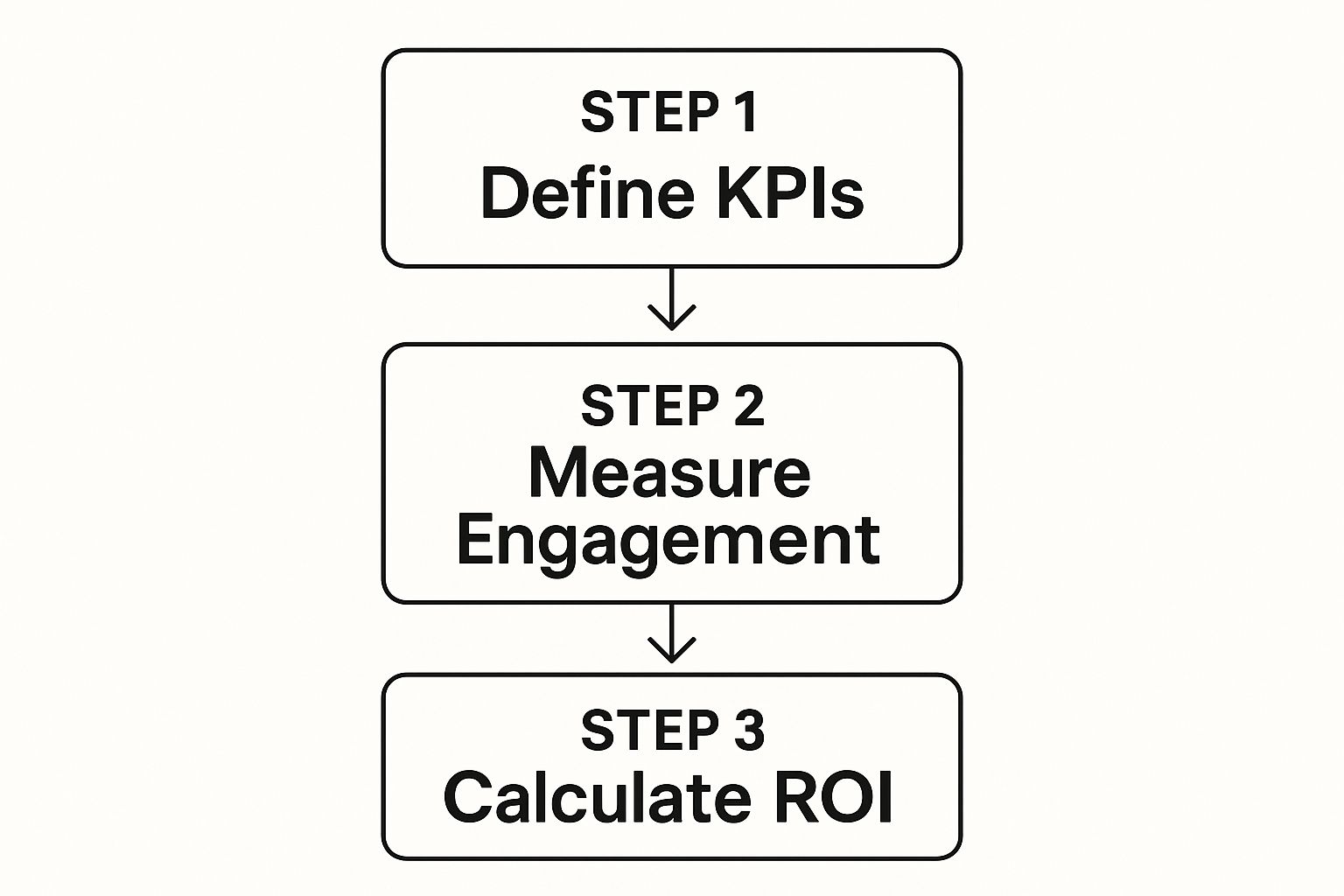
As you can see, proving value starts with clear goals and ends with a direct link to ROI. This is how you turn your LinkedIn activities into a predictable part of your sales engine.
Connecting Social Selling to Revenue
To properly measure your social media ROI, you have to get good at attributing leads and sales back to your LinkedIn efforts. Start by tracking these key performance indicators (KPIs):
- Qualified conversations started: How many new, relevant dialogues did you kick off this month?
- Meetings or demos booked: Of those chats, how many moved to the next step in your sales process?
- Pipeline generated from LinkedIn: What is the total dollar value of the opportunities you created?
- Deals closed with a LinkedIn touchpoint: Which closed-won deals can you trace back to your social selling?
Surprisingly, there’s a massive gap here. A staggering 93% of sales executives say they’ve had no formal training in social selling. Yet, the companies that do it right see incredible results—39% of B2B firms say they've generated revenue directly from social media. For even more precise tracking, you can utilize the LinkedIn Conversions API to connect the dots between your activity and actual business impact.
Answering Your Top Social Selling Questions
When you're getting started with social selling on LinkedIn, a few practical questions always pop up. It’s completely normal. Let's tackle these head-on so you can get back to building relationships and closing deals.
"How Much Time Do I Really Need to Spend on This Every Day?"
This is probably the most common question I get, and the answer is less than you think. Forget about spending hours glued to LinkedIn. Real results come from consistency, not cramming.
Aim for a focused 20-30 minutes a day. That's it. It's a small commitment that's easy to turn into a powerful habit. Use that time wisely to:
- Share one genuinely helpful piece of content.
- Leave thoughtful comments on a few posts from people in your network.
- Send out 3-5 connection requests that are actually personalized.
- Check in on any ongoing conversations in your inbox.
Doing this day in and day out is what builds momentum and keeps you top-of-mind without derailing your entire schedule.
"Do I Absolutely Need LinkedIn Sales Navigator?"
Look, Sales Navigator is a fantastic tool, but it's not a magic wand. You can get incredible results with the free version of LinkedIn, especially when you're just building your process. Mastering Boolean searches and focusing on authentic engagement will take you a long way.
My honest advice? Start free. Get your system down and prove the concept. Once you're consistently getting results and start feeling the limitations of the free platform, that's the perfect time to upgrade. Then, Sales Navigator becomes a smart investment that amplifies what you're already doing right.
"How Can I Actually Measure the ROI of Social Selling?"
You need to track two types of metrics to see the full picture: leading and lagging indicators.
Think of leading indicators as your daily habits—the things you can control. This includes your connection acceptance rate, how many comments you're leaving, and the engagement on your own posts. They tell you if your process is working.
Lagging indicators are the bottom-line business results. We're talking about qualified conversations started, meetings booked, and deals closed that you can trace back to your LinkedIn activity. Use a simple spreadsheet or tag them in your CRM to see exactly how your social selling efforts translate into revenue.
Ready to create scroll-stopping LinkedIn content that drives real engagement? autoghostwriter uses powerful AI to help you craft authentic, high-quality posts effortlessly. Stop staring at a blank screen and start building your authority today. Get started with autoghostwriter.